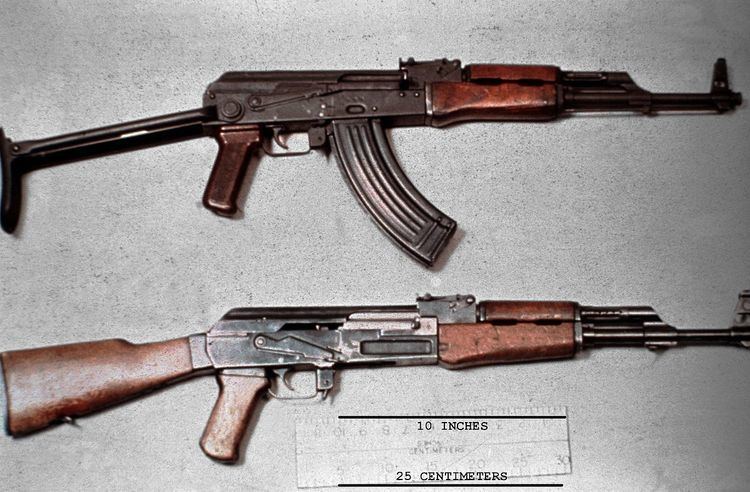 | ||
Wars Hungarian Revolution of 1956, Vietnam War | ||
How an AK-47 Works
The AK-47, or AK as it is officially known (also known as the Kalashnikov) is a selective-fire (semi-automatic and automatic), Gas-operated 7.62×39 mm assault rifle, developed in the Soviet Union by Mikhail Kalashnikov. It is officially known in the Soviet documentation as Avtomat Kalashnikova (Russian: Автомат Калашникова).
Contents
- How an AK 47 Works
- Origins
- Concept
- Early designs
- Further development
- Replacement
- Design
- Cartridge
- Operating mechanism
- Barrel
- Fire selector
- Sights
- Furniture
- Magazines
- Accessories
- Accuracy
- Service life
- Variants
- Outside of the Soviet UnionRussia
- Illicit trade
- Cultural influence and impact
- References
Design work on the AK-47 began in the last year of World War II (1945). In 1946, the AK-47 was presented for official military trials, and in 1948, the fixed-stock version was introduced into active service with selected units of the Soviet Army. An early development of the design was the AKS (S—Skladnoy or "folding"), which was equipped with an underfolding metal shoulder stock. In the spring of 1949, the AK-47 was officially accepted by the Soviet Armed Forces and used by the majority of the member states of the Warsaw Pact.
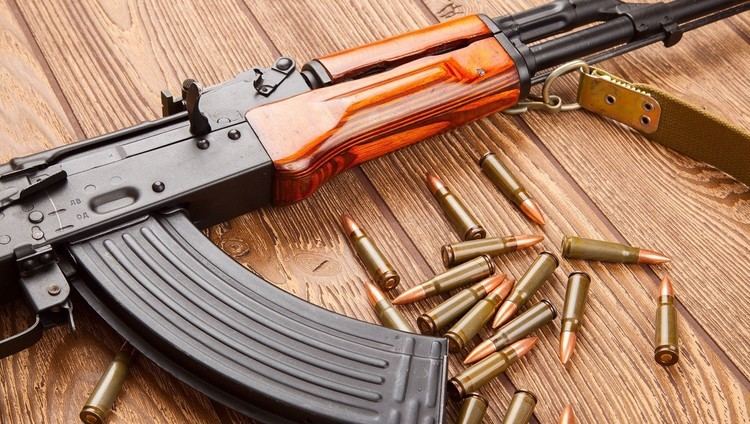
Even after almost seven decades, the model and its variants remain the most popular and widely used assault rifles in the world because of their substantial reliability under harsh conditions, low production costs compared to contemporary Western weapons, availability in virtually every geographic region and ease of use. The AK-47 has been manufactured in many countries and has seen service with armed forces as well as irregular forces worldwide, and was the basis for developing many other types of individual and crew-served firearms. As of 2004, "Of the estimated 500 million firearms worldwide, approximately 100 million belong to the Kalashnikov family, three-quarters of which are AK-47s".
Origins

During World War II, the Sturmgewehr 44 Assault rifle used by German forces made a deep impression on their Soviet counterparts. The select-fire rifle was chambered for a new intermediate cartridge, the 7.92×33mm Kurz, and combined the firepower of a submachine gun with the range and accuracy of a rifle. On 15 July 1943, an earlier model of the Sturmgewehr was demonstrated before the People's Commissariat of Arms of the USSR. The Soviets were impressed with the weapon and immediately set about developing an intermediate caliber automatic rifle of their own, to replace the PPSh-41 submachine guns and outdated Mosin–Nagant bolt-Action rifles that armed most of the Soviet Army.
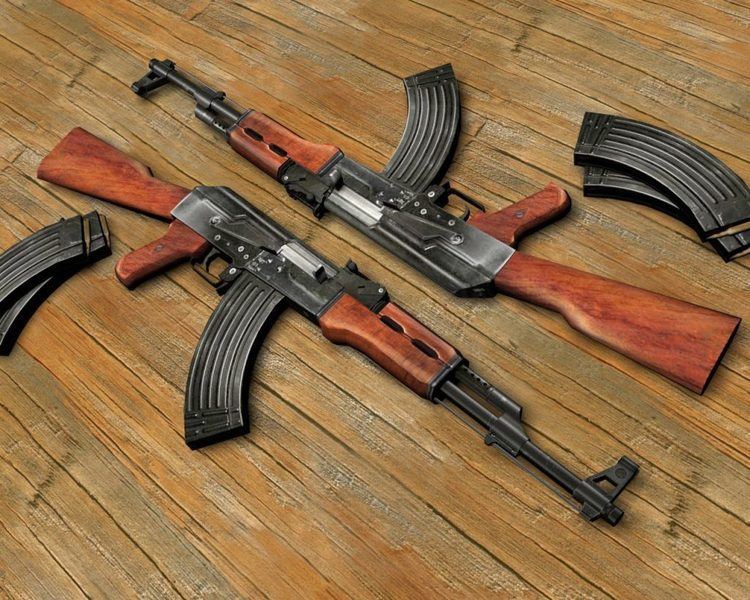
The Soviets soon developed the 7.62×39mm M43 Cartridge, the semi-automatic SKS carbine and the RPD light machine gun. Shortly after World War II, the Soviets developed the AK-47 assault rifle, which would quickly replace the SKS in Soviet service. In the 1960s, the Soviets introduced the RPK light machine gun, an AK-47 type weapon with a stronger receiver, a longer heavy barrel, and a bipod, that would eventually replace the RPD light machine gun.
Concept
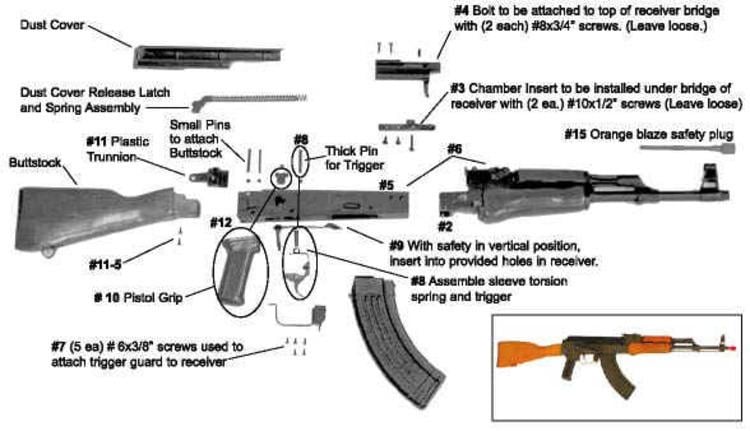
Mikhail Kalashnikov began his career as a weapon designer in 1941, while recuperating from a shoulder wound, which he received during the Battle of Bryansk. Kalashnikov himself stated..."I was in the hospital, and a soldier in the bed beside me asked: ‘Why do our soldiers have only one rifle for two or three of our men, when the Germans have automatics?’ So I designed one. I was a soldier, and I created a machine gun for a soldier. It was called an Avtomat Kalashnikova, the automatic weapon of Kalashnikov—AK—and it carried the date of its first manufacture, 1947."
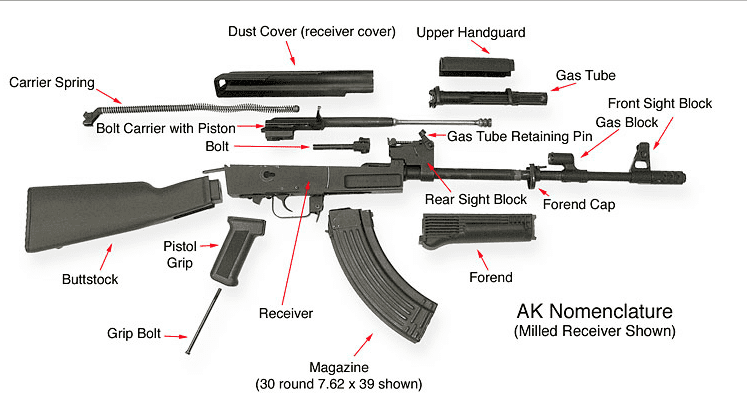
The AK-47 is best described as a hybrid of previous rifle technology innovations. "Kalashnikov decided to design an automatic rifle combining the best features of the American M1 and the German StG44." Kalashnikov's team had access to these weapons and had no need to "reinvent the wheel". Kalashnikov himself observed: "A lot of Russian Army soldiers ask me how one can become a constructor, and how new weaponry is designed. These are very difficult questions. Each designer seems to have his own paths, his own successes and failures. But one thing is clear: before attempting to create something new, it is vital to have a good appreciation of everything that already exists in this field. I myself have had many experiences confirming this to be so."
There are claims about Kalashnikov copying other designs, like Bulkin's TKB-415 or Simonov's AVS-31.
Early designs
Kalashnikov started work on a submachine gun design in 1942 and with a light machine gun in 1943. "Early in 1944, Kalashnikov was given some M1943 7.62×39mm cartridges and informed that there were several designers working on weapons for this new Soviet small-arms cartridge. It was suggested to him that this new weapon might well lead to greater things, and he undertook work on the new rifle." In 1944, he entered a design competition with this new 7.62×39mm, semi-automatic, gas-operated, long stroke piston, carbine, strongly influenced by the American M1 Garand. "The rifle that Kalashnikov designed was in the same class as the familiar SKS-45 Simonov with fixed magazine and gas tube above the Barrel." However, this new Kalashnikov design lost out to a Simonov design.
In 1946, a new design competition was initiated to develop a new assault rifle. Kalashnikov submitted an entry. It was gas-operated rifle with a short-stroke gas piston above the barrel, a breech-block mechanism similar to his 1944 carbine, and a curved 30-round magazine. Kalashnikov's rifles AK-1 (with a milled receiver) and AK-2 (with a stamped receiver) proved to be reliable weapons and were accepted to a second round of competition along with other designs.
These prototypes (also known as the AK-46) had a rotary bolt, a two-part receiver with separate trigger unit housing, dual controls (separate safety and fire selector switches) and a non-reciprocating charging handle located on the left side of the weapon. In late 1946, as the rifles were being tested, one of Kalashnikov's assistants, Aleksandr Zaitsev, suggested a major redesign to improve reliability. At first, Kalashnikov was reluctant, given that their rifle had already fared better than its competitors. Eventually, however, Zaitsev managed to persuade Kalashnikov.
In November 1947, the new prototypes (AK-47s) were completed. It utilized a long-stroke gas piston above the barrel. The upper and lower receivers were combined into a single receiver. The selector and safety were combined into a single control-lever/dust-cover on the right side of the rifle. And, the bolt-handle was simply attached to the bolt-carrier. This simplified the design and production of the rifle. The first army trial series began in early 1948. The new rifle proved to be reliable under a wide range of conditions with convenient handling characteristics. In 1949, it was adopted by the Soviet Army as "7.62 mm Kalashnikov assault rifle (AK)".
Further development
There were many difficulties during the initial phase of production. The first production models had stamped sheet metal receivers with a milled trunnion and butt stock insert, and a stamped body. Difficulties were encountered in welding the guide and ejector rails, causing high rejection rates. Instead of halting production, a heavy machined receiver was substituted for the sheet metal receiver. This was a more costly process, but the use of machined receivers accelerated production as tooling and labor for the earlier Mosin–Nagant rifle's machined receiver were easily adapted. Partly because of these problems, the Soviets were not able to distribute large numbers of the new rifle to soldiers until 1956. During this Time, production of the interim SKS rifle continued.
Once the manufacturing difficulties of non milled receivers had been overcome, a redesigned version designated the AKM (M for "modernized" or "upgraded"; in Russian: Автомат Калашникова Модернизированный [Avtomat Kalashnikova Modernizirovanniy]) was introduced in 1959. This new model used a stamped sheet metal receiver and featured a slanted muzzle brake on the end of the barrel to compensate for muzzle rise under recoil. In addition, a hammer retarder was added to prevent the weapon from firing out of battery (without the bolt being fully closed), during rapid or automatic fire. This is also sometimes referred to as a "cyclic rate reducer", or simply "rate reducer", as it also has the effect of reducing the number of rounds fired per minute during automatic fire. It was also roughly one-third lighter than the previous model.
Both licensed and unlicensed production of the Kalashnikov weapons abroad were almost exclusively of the AKM variant, partially due to the much easier production of the stamped receiver. This model is the most commonly encountered, having been produced in much greater quantities. All rifles based on the Kalashnikov design are frequently referred to as AK-47s in the West, although this is only correct when applied to rifles based on the original three receiver types. In most former Eastern Bloc countries, the weapon is known simply as the "Kalashnikov" or "AK". The differences between the milled and stamped receivers includes the use of rivets rather than welds on the stamped receiver, as well as the placement of a small dimple above the magazine well for stabilization of the magazine.
Replacement
In 1974, the Soviets began replacing their AK-47 and AKM rifles with a newer design, the AK-74, which uses 5.45×39mm ammunition. This new rifle and cartridge had only started to be manufactured in Eastern European nations when the Soviet Union collapsed, drastically slowing production of the AK-74 and other weapons of the former Soviet bloc.
Design
The AK-47 was engineered to embody simplicity and reliability as an automatic rifle, enabling its rapid and cost-effective mass production with the advanced manufacturing techniques available in the Soviet Union in the late 1940s. It employs a long-stroke gas system, renowned for its dependability under challenging conditions. Features such as a substantial gas piston, ample clearances among moving components, and a tapered cartridge case contribute to the firearm's ability to function reliably despite the presence of significant foreign matter and fouling.
Cartridge
The AK fires the 7.62×39mm cartridge with a muzzle velocity of 715 m/s (2,350 ft/s). The cartridge weight is 16.3 g (0.6 oz), the projectile weight is 7.9 g (122 gr). The original Soviet M43 bullets are 123 grain boat-tail bullets with a copper-plated steel jacket, a large steel core, and some lead between the core and the jacket. The AK has excellent penetration when shooting through heavy foliage, walls or a common vehicle's metal body and into an opponent attempting to use these things as cover. The 7.62×39mm M43 projectile does not generally fragment when striking an opponent and has an unusual tendency to remain intact even after making contact with bone. The 7.62×39mm round produces significant wounding in cases where the bullet tumbles (yaws) in tissue, but produces relatively minor wounds in cases where the bullet exits before beginning to yaw. In the absence of yaw, the M43 round can pencil through tissue with relatively little injury.
Most, if not all, of the 7.62×39mm ammunition found today is of the upgraded M67 variety. This variety deleted the steel insert, shifting the center of gravity rearward, and allowing the projectile to destabilize (or yaw) at about 3.3 in (8.4 cm), nearly 6.7 in (17 cm) earlier in tissue than the M43 round. This change also reduces penetration in ballistic gelatin to ~25 in (64 cm) for the newer M67 round versus ~29 in (74 cm) for the older M43 round. However, the wounding potential of M67 is mostly limited to the small permanent wound channel the bullet itself makes, especially when the bullet yaws.
Operating mechanism
To fire, the operator inserts a loaded magazine, pulls back and releases the charging handle, and then pulls the trigger. In semi-automatic, the firearm fires only once, requiring the trigger to be released and depressed again for the next shot. In full-automatic, the rifle continues to fire automatically cycling fresh rounds into the chamber, until the magazine is exhausted or pressure is released from the trigger. After ignition of the cartridge primer and propellant, rapidly expanding propellant gases are diverted into the gas cylinder above the barrel through a vent near the muzzle. The build-up of gases inside the gas cylinder drives the long-stroke piston and bolt carrier rearward and a cam guide machined into the underside of the bolt carrier along with an ejector spur on the bolt carrier rail guide, rotates the bolt approximately 35° and unlocks it from the barrel extension via a camming pin on the bolt. The moving assembly has about 5.5 mm (0.2 in) of free travel which creates a delay between the initial recoil impulse of the piston and the bolt unlocking sequence, allowing gas pressures to drop to a safe level before the seal between the chamber and the bolt is broken. The AK-47 does not have a gas valve; excess gases are ventilated through a series of radial ports in the gas cylinder. The Kalashnikov operating system offers no primary extraction upon bolt rotation, but uses an extractor claw to eject the spent cartridge case.
Barrel
The rifle received a barrel with a chrome-lined bore and four right-hand grooves at a 240 mm (1 in 9.45 in) rifling twist rate. The gas block contains a gas channel that is installed at a slanted angle in relation to the bore axis. The muzzle is threaded for the installation of various muzzle devices such as a muzzle brake or a blank-firing adaptor.
Fire selector
The fire selector is a large lever located on the right side of the rifle, it acts as a dust-cover and prevents the charging handle from being pulled fully to the rear when it is on safe. It is operated by the shooter's right fore-fingers and has 3 settings: safe (up), full-auto (center), and semi-auto (down). The reason for this is that under stress a soldier will push the selector lever down with considerable force bypassing the full-auto stage and setting the rifle to semi-auto. To set the AK-47 to full-auto requires the deliberate action of centering the selector lever. To operate the fire selector lever, right handed shooters have to briefly remove their right hand from the pistol grip, which is ergonomically sub-optimal. Some AK-type rifles also have a more traditional selector lever on the left side of the receiver just above the pistol grip. This lever is operated by the shooter's right thumb and has three settings: safe (forward), full-auto (center), and semi-auto (backward).
Sights
The AK-47 uses a notched rear tangent iron sight calibrated in 100 m (109 yd) increments from 100 to 800 m (109 to 875 yd). The front sight is a post adjustable for elevation in the field. Horizontal adjustment requires a special drift tool and is done by the armory before issue or if the need arises by an armorer after issue. The sight line elements are approximately 48.5 mm (1.9 in) over the bore axis. The "point-blank range" battle zero setting "П" on the 7.62×39mm AK-47 rear tangent sight element corresponds to a 300 m (328 yd) zero. These settings mirror the Mosin–Nagant and SKS rifles which the AK-47 replaced. For the AK-47 combined with service cartridges the 300 m battle zero setting limits the apparent "bullet rise" within approximately −5 to +31 cm (−2.0 to 12.2 in) relative to the line of sight. Soldiers are instructed to fire at any target within this range by simply placing the sights on the center of mass (the belt buckle) of the enemy target. Any errors in range estimation are tactically irrelevant, as a well-aimed shot will hit the torso of the enemy soldier. Some AK-type rifles have a front sight with a flip-up luminous dot that is calibrated at 50 m (55 yd), for improved night fighting.
Furniture
The AK-47 was originally equipped with a buttstock, handguard and an upper heat guard made from solid wood. With the introduction of the Type 3 receiver the buttstock, lower handguard and upper heatguard were manufactured from birch plywood laminates. Such engineered woods are stronger and resist warping better than the conventional one-piece patterns, do not require lengthy maturing, and are cheaper. The wooden furniture was finished with the Russian amber shellac finishing process. AKS and AKMS models featured a downward-folding metal butt-stock similar to that of the German MP40 submachine-gun, for use in the restricted space in the BMP infantry combat vehicle, as well as by paratroops. All 100 series AKs use plastic furniture with side-folding stocks.
Magazines
The standard magazine capacity is 30 rounds. There are also 10, 20, and 40-round box magazines, as well as 75-round drum magazines.
The AK-47's standard 30-round magazines have a pronounced curve that allows them to smoothly feed ammunition into the chamber. Their heavy steel construction combined with "feed-lips" (the surfaces at the top of the magazine that control the angle at which the cartridge enters the chamber) machined from a single steel billet makes them highly resistant to damage. These magazines are so strong that "Soldiers have been known to use their mags as hammers, and even bottle openers." This contributes to the AK-47 magazine being more reliable, but makes it heavier than U.S. and NATO magazines.
The early slab-sided steel AK-47 30-round detachable box magazines had 1 mm (0.039 in) sheet-metal bodies and weigh 0.43 kg (0.95 lb) empty. The later steel AKM 30-round magazines had lighter sheet-metal bodies with prominent reinforcing ribs weighing 0.33 kg (0.73 lb) empty. To further reduce weight a light weight magazine with an aluminum body with a prominent reinforcing waffle rib pattern weighing 0.19 kg (0.42 lb) empty was developed for the AKM that proved to be too fragile and the small issued amount of these magazines were quickly withdrawn from service. As a replacement steel-reinforced 30-round plastic 7.62×39mm box magazines were introduced. These rust-colored magazines weigh 0.24 kg (0.53 lb) empty and are often mistakenly identified as being made of Bakelite (a phenolic resin), but were actually fabricated from two-parts of AG-S4 molding compound (a glass-reinforced phenol-formaldehyde binder impregnated composite), assembled using an epoxy resin adhesive. Noted for their durability, these magazines did however compromise the rifle's camouflage and lacked the small horizontal reinforcing ribs running down both sides of the magazine body near the front that were added on all later plastic magazine generations. A second generation steel-reinforced dark-brown (color shades vary from maroon to plum to near black) 30-round 7.62×39mm magazine was introduced in the early 1980s, fabricated from ABS plastic. The third generation steel-reinforced 30-round 7.62×39mm magazine is similar to the second generation, but is darker colored and has a matte nonreflective surface finish. The current issue steel-reinforced matte true black nonreflective surface finished 7.62×39mm 30-round magazines, fabricated from ABS plastic weigh 0.25 kg (0.55 lb) empty. Early steel AK-47 magazines are 9.75 in (248 mm) long, and the later ribbed steel AKM and newer plastic 7.62×39mm magazines are about 1 in (25 mm) shorter.
The transition from steel to mainly plastic magazines yields a significant weight reduction and allows a soldier to carry more ammunition for the same weight.
All 7.62×39mm AK magazines are backwards compatible with older AK variants.
10.12 kg (22.3 lb) is the maximum amount of ammo that the average soldier can comfortably carry. It also allows for best comparison of the three most common 7.62×39mm AK magazines.
Most Yugoslavian and some East German AK magazines were made with cartridge followers that hold the bolt open when empty; however, most AK magazine followers allow the bolt to close when the magazine is empty.
Accessories
Accessories supplied with the rifle include a 387 mm (15.2 in) long 6H3 bayonet featuring a 200 mm (7.9 in) long spear point blade. The AK-47 bayonet is installed by slipping the 17.7 mm (0.70 in) diameter muzzle ring around the muzzle and latching the handle down on the bayonet lug under the front sight base.
All current model AKM rifles can mount under-barrel 40 mm grenade launchers such as the GP-25 and its variants, which can fire up to 20 rounds per minute and have an effective range of up to 400 metres. The main grenade is the VOG-25 (VOG-25M) fragmentation grenade which has a 6 m (9 m) (20 ft (30 ft)) lethality radius. The VOG-25P/VOG-25PM ("jumping") variant explodes 0.5–1 metre (1.6–3.3 ft) above the ground.
The AK-47 can also mount a (rarely used) cup-type grenade launcher, the Kalashnikov grenade launcher that fires standard RGD-5 Soviet hand-grenades. The maximum effective range is approximately 150 meters. This launcher can also be used to launch tear-gas and riot control grenades.
All current AKs (100 series) and some older models, have side rails for mounting a variety of scopes and sighting devices, such as the PSO-1 Optical Sniper Sight. The side rails allow for removal and remounting of optical accessories without interfering with the zeroing of the optic. However, the 100 series side folding stocks cannot be folded with the optics mounted.
Accuracy
The AK-47's accuracy has always been considered to be "good enough" to hit an adult male torso out to about 300 m (328 yd), though even experts firing from prone or bench rest positions at this range were observed to have difficulty placing ten consecutive rounds on target. Later designs did not significantly improve its accuracy. An AK can fire a 10-shot group of 5.9 in (15 cm) at 100 m (109 yd), and 17.5 in (44 cm) at 300 m (328 yd) The newer stamped-steel receiver AKM models, while more rugged and less prone to metal fatigue, are actually less accurate than the forged/milled receivers of their predecessors: the milled AK-47s are capable of shooting 3 to 5 in (8 to 13 cm) groups at 100 yd (91 m), whereas the stamped AKMs are capable of shooting 4 to 6 in (10 to 15 cm) groups at 100 yd (91 m).
The best shooters are able to hit a man-sized target at 800 m (875 yd) within five shots (firing from prone or bench rest position) or ten shots (standing).
The single-shot hit-probability on the NATO E-type Silhouette Target (a human upper body half and head silhouette) of the AK-47 and the later developed AK-74, M16A1 and M16A2 assault rifles were measured by the US military under ideal proving ground conditions in the 1980s as follows:
Under worst field exercise circumstances, due to range estimation and aiming errors, the hit probabilities for the tested assault rifles were drastically reduced with differences without operational significance.
Service life
The AK-47 and its variants are made in dozens of countries, with "quality ranging from finely engineered weapons to pieces of questionable workmanship." As a result, the AK-47 has a service/system life of approximately 6,000, to 10,000, to 15,000 rounds. The AK-47 was designed to be a cheap, simple, easy to manufacture assault rifle, perfectly matching Soviet military doctrine that treats equipment and weapons as disposable items. As units are often deployed without adequate logistical support and dependent on "battlefield cannibalization" for resupply, it is actually more cost-effective to replace rather than repair weapons.
The AK-47 has small parts and springs that need to be replaced every few thousand rounds. However, "Every time it is disassembled beyond the field stripping stage, it will take some time for some parts to regain their fit, some parts may tend to shake loose and fall out when firing the weapon. Some parts of the AK-47 line are riveted together. Repairing these can be quite a hassle, since the end of the rivet has to be ground off and a new one set after the part is replaced."
Variants
Outside of the Soviet Union/Russia
Kalashnikov Concern (formerly Izhmash) has repeatedly claimed that the majority of foreign manufacturers are producing AK type rifles without proper licensing.
Illicit trade
Throughout the world, the AK and its variants are commonly used by governments, revolutionaries, terrorists, criminals, and civilians alike. In some countries, such as Somalia, Rwanda, Mozambique, Congo and Tanzania, the prices for black market AKs are between $30 and $125 per weapon and prices have fallen in the last few decades due to mass counterfeiting. In Kenya "an AK-47 fetches 5 head of cattle (about 10,000 Kenya shillings or 100 U.S. dollars) when offered for barter but costs almost half that price when cash is paid." There are places around the world where AK type weapons can be purchased on the Black Market "for as little as $6, or traded for a chicken or a sack of grain."
The AK-47 has also spawned a cottage industry of sorts and has been copied and manufactured (one gun at a time) in small shops around the world (see Khyber Pass Copy). The estimated numbers of AK-type weapons vary greatly. The Small Arms Survey suggest that "between 70 and 100 million of these weapons have been produced since 1947." The World Bank estimates that out of the 500 million total firearms available worldwide, 100 million are of the Kalashnikov family, and 75 million are AK-47s. Because AK-type weapons have been made in many countries, often illicitly, it is impossible to know how many really exist.
Cultural influence and impact
During the Cold War, the Soviet Union and the People's Republic of China, as well as United States and other NATO nations supplied arms and technical knowledge to numerous countries and rebel forces around the world. During this time the Western countries used relatively expensive automatic rifles, such as the FN FAL, the HK G3, the M14, and the M16. In contrast, the Russians and Chinese used the AK-47; its low production cost and ease of manufacture allow them to make AKs in vast numbers.
In the pro-communist states, the AK-47 became a symbol of third-world revolution. During the 1980s, the Soviet Union became the principal arms dealer to countries embargoed by Western nations, including Middle Eastern nations such as Iran, Libya, and Syria, which welcomed Soviet Union backing against Israel. After the fall of the Soviet Union, AK-47s were sold both openly and on the black market to any group with cash, including drug cartels and dictatorial states, and more recently they have been seen in the hands of Islamic groups such as Al-Qaeda, ISIL, and the Taliban in Afghanistan and Iraq, and FARC, Ejército de Liberación Nacional guerrillas in Colombia.
In Russia, the Kalashnikov is a tremendous source of national pride. "The family of the inventor of the world's most famous assault rifle, Mikhail Kalashnikov, has authorized German engineering company MMI to use the well-known Kalashnikov name on a variety of not-so-deadly goods." In recent years, Kalashnikov Vodka has been marketed with souvenir bottles in the shape of the AK-47 Kalashnikov. There are also Kalashnikov watches, umbrellas, and knives.
In Izhevsk, Udmurt Republic, the Kalashnikov Museum (also called the AK-47 museum) opened on 4 November 2004. This city is in the Ural Region of Russia. The museum chronicles the biography of General Kalashnikov and documents the invention of the AK-47. The museum complex of Kalashnikov's small arms, a series of halls, and multimedia exhibitions are devoted to the evolution of the AK-47 assault rifle and attracts 10,000 monthly visitors. Nadezhda Vechtomova, the museum director, stated in an interview that the purpose of the museum is to honor the ingenuity of the inventor and the hard work of the employees and to "separate the weapon as a weapon of murder from the people who are producing it and to tell its history in our country."
The proliferation of this weapon is reflected by more than just numbers. The AK-47 is included in the flag of Mozambique and its emblem, an acknowledgment that the country gained its independence in large part through the effective use of their AK-47s. It is also found in the coats of arms of East Timor and the revolution era Burkina Faso, as well as in the flags of the Hezbollah and New People's Army.
Some Western countries associate the AK-47 with their enemies; both Cold War era and present-day. For example, Western movies often portray criminals, gang members and terrorists using AK-47s. For these reasons, in the U.S. and Western Europe the AK-47 is stereotypically regarded as the weapon of choice of insurgents, gangsters and terrorists. Conversely, throughout the developing world, the AK-47 can be positively attributed with revolutionaries against foreign occupation, imperialism, or colonialism.
The AK-47 made an appearance in U.S. popular culture as a recurring focus in the Nicolas Cage film Lord of War (2005). Numerous monologues in the movie focus on the weapon, and its effects on global conflict and the gun running market.
In 2006, Colombian musician and peace activist César López devised the escopetarra, an AK converted into a guitar. One sold for US$17,000 in a fundraiser held to benefit the victims of anti-personnel mines, while another was exhibited at the United Nations' Conference on Disarmament.
In Mexico, the AK-47 is known as "Cuerno de Chivo" (literally "Goat's Horn") because of its curved magazine design and is one of the weapons of choice of Mexican drug cartels. It is sometimes mentioned in Mexican folk music lyrics.
